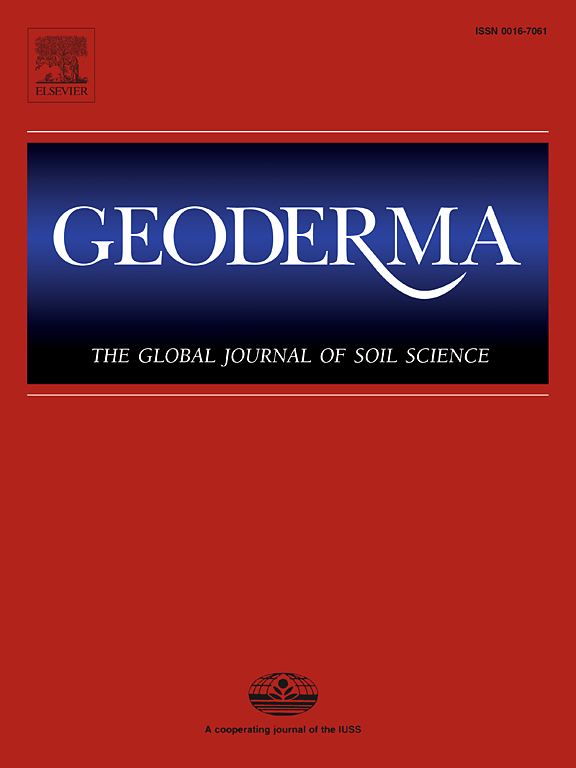生态系统水平的变暖减少了亚热带森林表层土壤的微生物坏死,但没有减少深层土壤的微生物坏死
IF 6.6
1区 农林科学
Q1 SOIL SCIENCE
引用次数: 0
摘要
亚热带地区气温上升对土壤碳(C)储量构成重大挑战。微生物坏死团是维持土壤C库的重要贡献者,但对其对亚热带森林生态系统变暖的响应知之甚少。在亚热带森林生态系统被动增温实验(+0°C, +1.0°C和+2.1°C)中,我们进行了8年的连续采样。我们观察到,在较高的温度下,土壤微生物坏死团C下降。+2°C升温使表层土壤(0-10 cm)微生物坏死块C显著降低23%,部分原因是植物生长对氮需求增加导致土壤氮减少,以及土壤干燥和微生物生物量减少。然而,我们发现,在升温条件下,下层土壤(10-40 cm)微生物坏死团C没有变化。随机森林分析和结构方程模型表明,这种随土壤深度衰减的效应主要是由于深层土壤中矿物质保护作用增强,深层土壤中微生物组成更稳定。为了准确预测气候变化对亚热带森林的影响,在地球系统模型中应考虑微生物坏死团的深度依赖温度响应。本文章由计算机程序翻译,如有差异,请以英文原文为准。

Ecosystem-level warming reduces microbial necromass in the topsoil but not in deeper soil of a subtropical forest
Rising temperatures in subtropical regions pose a significant challenge to soil carbon (C) storage. Microbial necromass is an important contributor to the persistent soil C pool, yet little is known about its responses to warming in subtropical forest ecosystems. Here, we executed an 8-year continuous sampling campaign in a subtropical forest ecosystem-level passive warming experiment (+0 °C, +1.0 °C and +2.1 °C). We observed a decline in soil microbial necromass C under higher temperatures. +2 °C warming significantly reduced the topsoil (0–10 cm) microbial necromass C by 23 %, partially due to the decreased soil nitrogen caused by the elevated nitrogen requirements of plant growth, as well as the soil drying and decrease in microbial biomass. However, we found that the subsoil (10–40 cm) microbial necromass C was unchanged under warming. Random forest analysis and structural equation models suggested that this attenuated effect with soil depth was primarily attributed to the enhanced mineral protection in deeper soil and more stable microbial composition in deeper soil. The depth-dependent temperature response of microbial necromass should be considered in Earth system models to obtain accurate predictions of climate change impacts on subtropical forests.
求助全文
通过发布文献求助,成功后即可免费获取论文全文。
去求助
来源期刊

Geoderma
农林科学-土壤科学
CiteScore
11.80
自引率
6.60%
发文量
597
审稿时长
58 days
期刊介绍:
Geoderma - the global journal of soil science - welcomes authors, readers and soil research from all parts of the world, encourages worldwide soil studies, and embraces all aspects of soil science and its associated pedagogy. The journal particularly welcomes interdisciplinary work focusing on dynamic soil processes and functions across space and time.
 求助内容:
求助内容: 应助结果提醒方式:
应助结果提醒方式:


